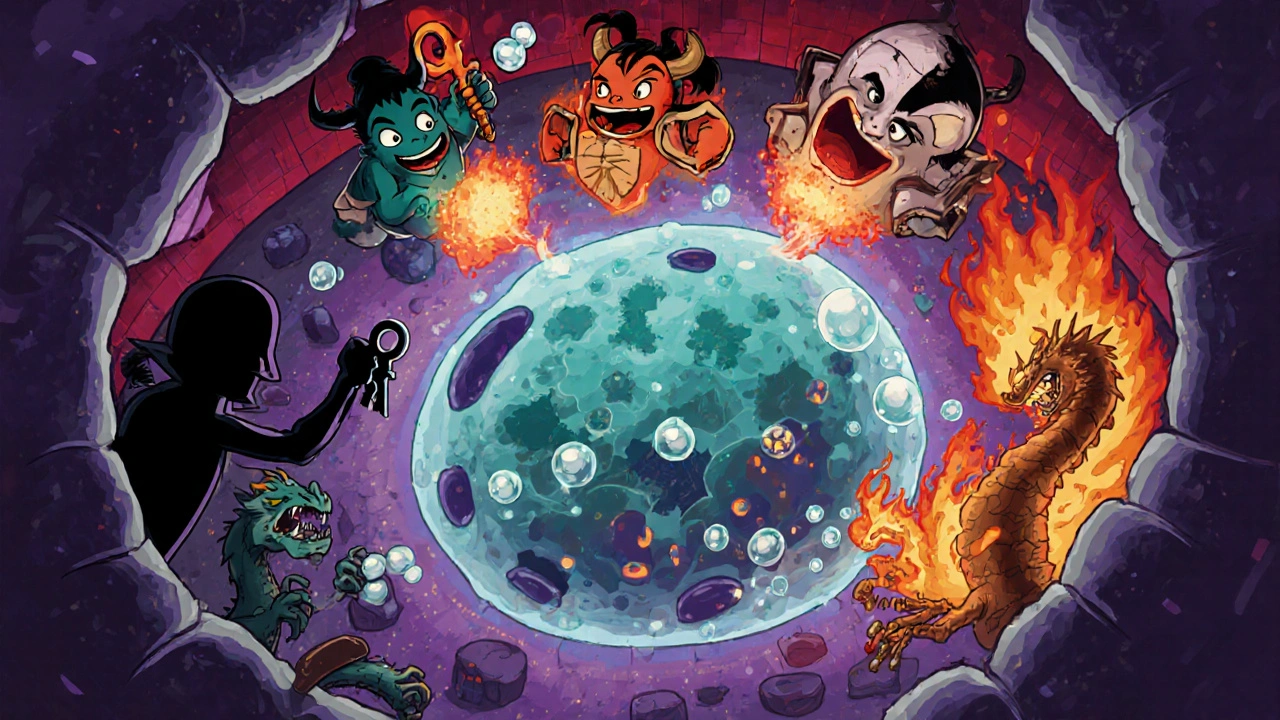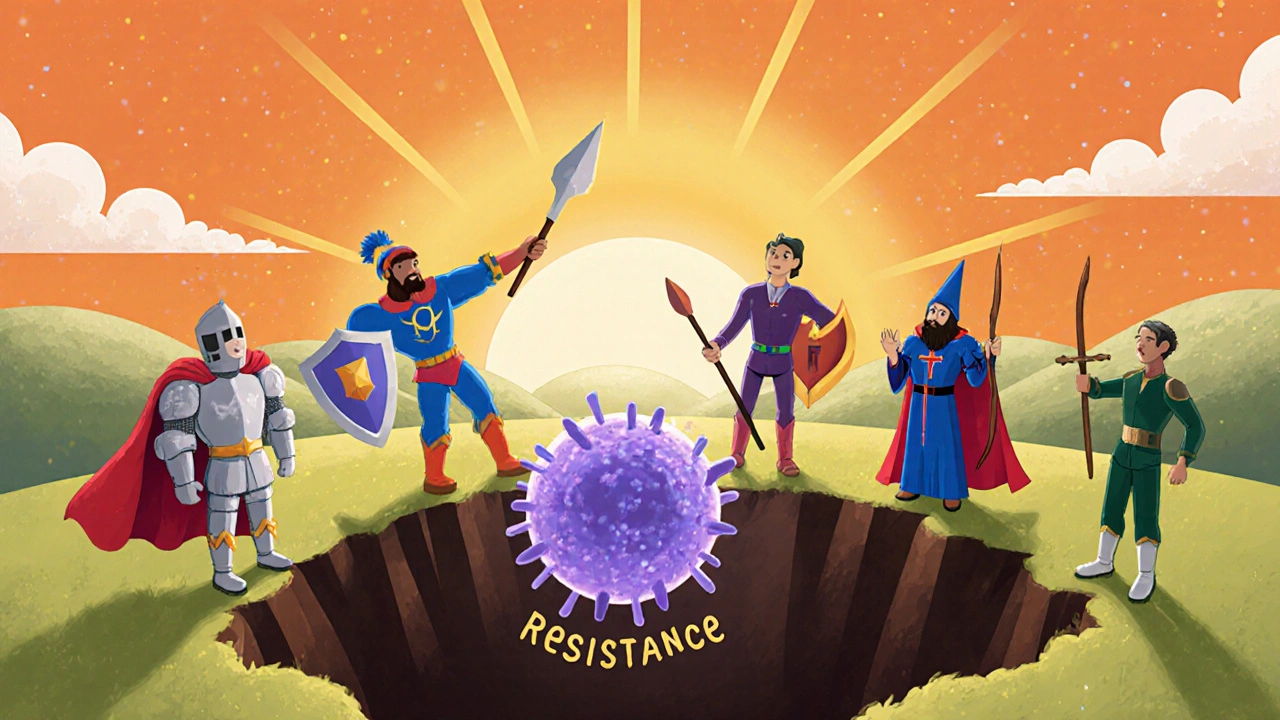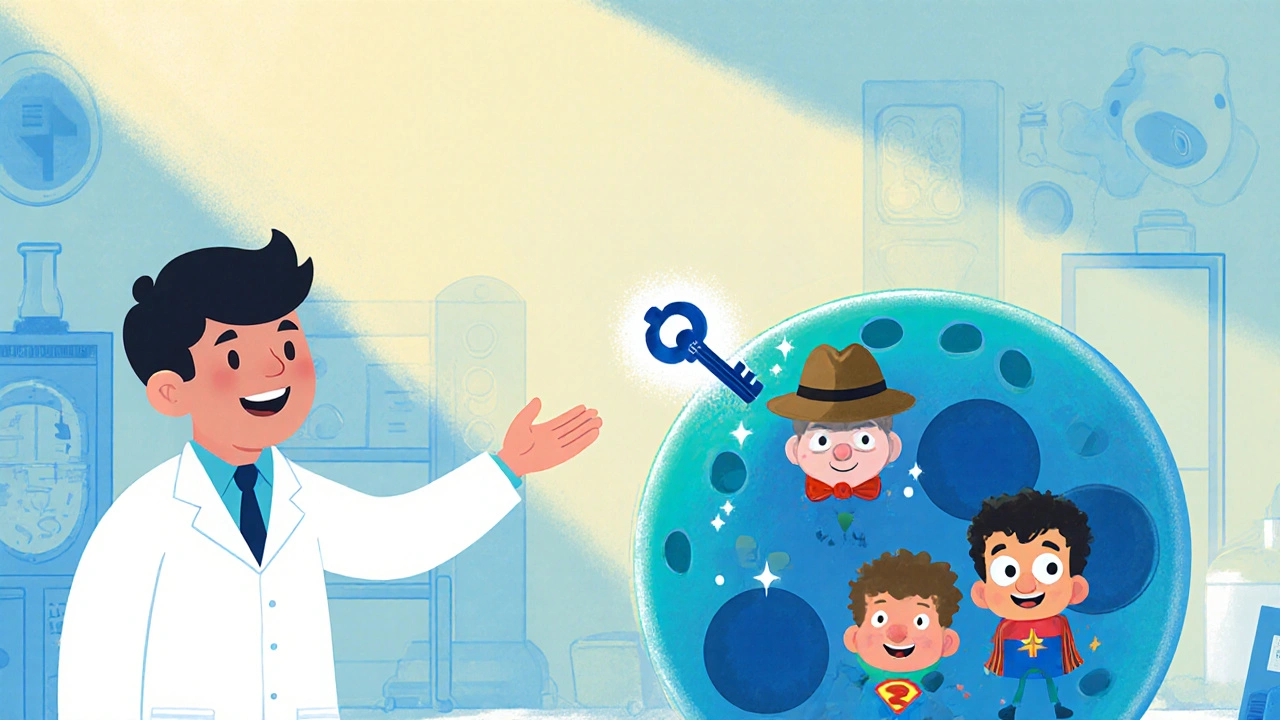Pomalidomide Resistance Assessment Tool
Resistance Mechanism Assessment
Enter biomarker information to identify likely resistance mechanisms and receive tailored treatment recommendations
Treatment Recommendations
When treating Pomalidomide is a third‑generation immunomodulatory drug (IMiD) approved for relapsed/refractory Multiple Myeloma. It has saved countless patients, but a growing hurdle is pomalidomide resistance. In this article we unpack why resistance occurs, which molecular tricks cancer cells use, and what clinicians can do today to stay ahead.
What is pomalidomide?
Pomalidomide is a synthetic analogue of thalidomide, designed to bind the cereblon (CRBN) component of the CRL4CRBN E3 ubiquitin ligase complex. Once bound, it triggers the ubiquitination and degradation of transcription factors IKZF1 and IKZF3, leading to anti‑myeloma activity through apoptosis and immune modulation.
How does pomalidomide work?
The drug’s primary action hinges on Cereblon (CRBN). By altering the substrate specificity of the CRL4CRBN ligase, pomalidomide earmarks IKZF1 and IKZF3 for proteasomal destruction. Their loss lifts repression on downstream genes like interferon‑γ, boosting T‑cell and NK‑cell mediated killing of myeloma cells.
Why does resistance emerge?
Even the best drugs meet the cancer’s adaptability. Resistance isn’t a single event; it’s a collection of genetic and epigenetic shifts that let myeloma cells dodge pomalidomide’s lethal pull. Below we outline the most common culprits, supported by data from recent cohort studies.
Key molecular drivers of pomalidomide resistance
- Cereblon loss or mutation: Up to 30% of resistant patients show reduced CRBN mRNA or protein levels. Certain point mutations (e.g., Y384C) directly impair pomalidomide binding.
- IKZF1/IKZF3 alterations: Mutations that prevent their recognition by the CRL4CRBN complex keep these transcription factors alive, nullifying the drug’s downstream effects.
- Drug efflux pumps (especially ABCB1/P‑gp): Overexpression can lower intracellular pomalidomide concentrations by 2‑3‑fold, as shown in xenograft models.
- Alternative survival pathways: Constitutive activation of MAPK, NF‑κB, or JAK/STAT signaling provides a bypass route for cells, documented in 15-20% of resistant biopsies.
- Epigenetic rewiring: Hypermethylation of CRBN promoter or histone modifications that silence CRBN transcription have been linked to progressive disease.

Clinical impact of resistance
In the Phase 3 MM‑003 trial, pomalidomide plus dexamethasone achieved a median progression‑free survival (PFS) of 4.2 months. Real‑world registries now report that 40-45% of patients progress within the first three months, correlating with the molecular mechanisms above. Recognizing resistance early can spare patients ineffective therapy and open the door to alternative regimens.
Strategies to overcome pomalidomide resistance
Researchers and clinicians have converged on several practical approaches:
- Combination therapy: Pairing pomalidomide with proteasome inhibitors (e.g., bortezomib) or monoclonal antibodies (e.g., daratumumab) restores apoptotic signaling in CRBN‑low cells. A 2024 meta‑analysis showed a 22% improvement in overall response rate when pomalidomide was combined with daratumumab.
- Next‑generation IMiDs: Agents like iberdomide (CC‑220) bind CRBN with higher affinity, overcoming some loss‑of‑function mutations. Early‑phase trials report response rates of 35% in pomalidomide‑failed cohorts.
- Cereblon agonists / modulators: Small molecules that up‑regulate CRBN expression or stabilize its interaction with pomalidomide are in pre‑clinical pipelines (e.g., NPR‑001).
- Epigenetic drugs: Low‑dose azacitidine or HDAC inhibitors can demethylate the CRBN promoter, re‑sensitizing cells. A 2023 study demonstrated a 1.8‑fold increase in CRBN mRNA after azacitidine priming.
- Targeting downstream pathways: Inhibitors of MAPK (trametinib) or JAK/STAT (ruxolitinib) have rescued pomalidomide activity in vitro when the respective pathways were hyperactive.
- Adaptive dosing schedules: Intermittent high‑dose pomalidomide followed by a drug‑holiday can limit efflux pump up‑regulation, as suggested by pharmacokinetic modeling.
Emerging clinical trials and research directions
Several Phase 2/3 studies are now enrolling patients who have documented pomalidomide resistance:
- **Study IMiD‑203**: Iberdomide + daratumumab + lenalidomide in CRBN‑low myeloma.
- **Study EPIC‑101**: Azacitidine priming before pomalidomide/dexamethasone.
- **Study CERE‑302**: Novel CRBN‑stabilizer NPR‑001 combined with bortezomib.
Results are expected early 2026, and they could reshape standard‑of‑care algorithms for relapsed disease.

Practical checklist for clinicians
- Screen baseline CRBN expression (RT‑PCR or immunohistochemistry) before initiating pomalidomide.
- If CRBN is low, consider upfront combination with a monoclonal antibody.
- Re‑assess IKZF1/3 mutation status at progression using next‑generation sequencing.
- Test for ABCB1 over‑expression when rapid relapse occurs; if positive, add a P‑gp inhibitor (e.g., elacridar) in a clinical‑trial setting.
- Monitor MAPK/NF‑κB activity via phospho‑ERK or IκBα levels in resistant biopsies to guide targeted addition.
- Enroll eligible patients in ongoing trials targeting CRBN restoration or next‑gen IMiDs.
Frequently Asked Questions
What defines pomalidomide resistance?
Resistance is usually declared when a patient’s disease progresses despite ≥2 cycles of pomalidomide + dexamethasone, accompanied by molecular evidence such as CRBN loss, IKZF mutations, or activation of bypass pathways.
How common is CRBN loss in resistant myeloma?
Studies in 2022‑2024 report CRBN down‑regulation in roughly 30 % of pomalidomide‑failed patients, making it the single most frequent molecular driver.
Can I still use pomalidomide after resistance develops?
Yes, if you pair it with agents that bypass the resistance mechanism-e.g., daratumumab for CRBN‑low disease or an MAPK inhibitor for pathway‑driven resistance.
Are there any FDA‑approved drugs that target the same pathway?
While no drug directly restores CRBN function, iberdomide received FDA breakthrough‑therapy designation in 2024 for pomalidomide‑refractory myeloma, offering a higher‑affinity CRBN binder.
What should I monitor if I start a combination regimen?
Track complete blood counts, renal function, and specific biomarkers like serum free light chains. Also watch for infusion‑related reactions when adding monoclonal antibodies.
Bottom line
Understanding the biology behind pomalidomide resistance equips clinicians to pivot quickly-whether that means adding a targeted inhibitor, enrolling a patient in a trial, or switching to a next‑generation IMiD. The battle isn’t over; it’s evolving, and staying informed is the best defense.


Kirsten Youtsey
October 20, 2025 AT 22:54While the authors have compiled an exhaustive list of mechanisms, the underlying narrative betrays a simplistic optimism that ignores the shadowy alliances between pharmaceutical conglomerates and regulatory agencies. One cannot help but suspect that the push for next‑generation IMiDs serves more as a façade to prolong market exclusivity than a genuine quest for cure. The emphasis on combination therapies, though scientifically sound, conveniently sidesteps the ethical imperative of transparent risk disclosure. Moreover, the article fails to acknowledge the covert lobbying that influences trial designs, often to the detriment of patients seeking real alternatives. In an era where data integrity is paramount, such omissions are nothing short of academic negligence.
Matthew Hall
October 25, 2025 AT 13:54Man, the whole pomalidomide saga feels like a soap opera where the villains wear lab coats. Every time they announce a new combo, I half expect a secret board meeting where big pharma whispers about extending their profit runway. The way resistance pops up so fast makes you wonder if they're secretly seeding the tumors with resistant clones. And when the doctors start talking about 'adaptive dosing,' it sounds like code for 'we’s buying more time to sell more pills.'
Vijaypal Yadav
October 30, 2025 AT 04:54From a mechanistic standpoint, pomalidomide resistance can be dissected into at least three convergent pathways: loss‑of‑function mutations in CRBN, up‑regulation of ATP‑binding cassette transporters, and activation of alternative survival cascades such as MAPK and JAK/STAT. Recent whole‑exome sequencing cohorts have identified the Y384C CRBN point mutation as a recurrent alteration correlating with a three‑fold reduction in drug binding affinity. In vitro studies further demonstrate that pharmacological inhibition of ABCB1 restores intracellular concentrations to therapeutic levels, thereby resensitizing cells to pomalidomide. Epigenetically, hyper‑methylation of the CRBN promoter has been quantified using bisulfite sequencing, revealing a methylation density increase from 12 % in responders to 48 % in non‑responders. These data collectively suggest that a multiplexed diagnostic panel incorporating genomic, transcriptomic, and epigenomic markers would significantly enhance early detection of impending resistance.
Ron Lanham
November 3, 2025 AT 19:54The emergence of pomalidomide resistance is not merely a scientific inconvenience, it is a moral indictment of our complacency. When we celebrate a drug as a miracle without scrutinizing the mechanisms that allow cancer cells to outwit it, we betray the trust of patients. The data showing CRBN loss in up to thirty percent of relapsed cases should have spurred an immediate overhaul of treatment protocols. Instead, pharmaceutical giants continue to push marginal variations while ignoring the deeper genetic betrayals. This pattern reflects a systemic failure where profit eclipses prudence, and the vulnerable are left to endure suboptimal regimens. Ethical practice demands that clinicians incorporate early biomarker testing rather than waiting for clinical failure. Moreover, the community must demand that trials prioritize agents that directly restore CRBN function instead of merely adding more immunomodulators. The reliance on high‑dose pomalidomide schedules to overcome efflux pumps is a cynical stopgap that disregards patient quality of life. A responsible approach would integrate epigenetic priming with azacitidine in a timely manner, as evidence suggests meaningful re‑sensitization. We must also confront the reality that off‑label use of MAPK inhibitors without proper molecular justification is an ethically dubious shortcut. It is imperative that regulatory bodies enforce transparent reporting of CRBN and IKZF mutation statuses in every trial. Physicians have a duty to educate patients about the likelihood of resistance, furnishing them with realistic expectations. The oncology community should foster collaborative registries to track resistance patterns globally, not hide behind fragmented data silos. Only through collective vigilance can we transform resistance from an inevitable destiny into a preventable obstacle. In short, the fight against pomalidomide resistance must be waged with both scientific rigor and uncompromising moral clarity.
jessie cole
November 8, 2025 AT 10:54Ron, you hit the nail on the head with the ethical concerns-patients deserve more than a patchwork of combos. A practical step is to start every treatment course with a CRBN expression assay, then tailor the regimen accordingly. Simple measures like adding a P‑gp inhibitor when ABCB1 is high can make a real difference without overcomplicating care. Let’s keep pushing for trials that test CRBN‑restoring agents head‑on, because the future belongs to those who prioritize real cure over convenience.
Deja Scott
November 13, 2025 AT 01:54Awareness of resistance mechanisms is crucial for timely intervention.
Natalie Morgan
November 17, 2025 AT 16:54I wonder how often clinicians actually order CRBN sequencing before starting pomalidomide it seems underutilized but could change outcomes dramatically
Mahesh Upadhyay
November 22, 2025 AT 07:54Matthew, your dramatic flair masks the very real fact that unchecked commercial interests are steering research toward profit rather than patient benefit.
Rajesh Myadam
November 26, 2025 AT 22:54Deja, I completely agree-early detection can spare patients unnecessary toxicity and give them a clearer path forward.